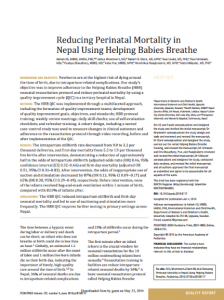
Objective
Newborns are at the highest risk of dying around the time of birth, due to intrapartum-related complications. Our study’s objective was to improve adherence to the Helping Babies Breathe (HBB) neonatal resuscitation protocol and reduce perinatal mortality using a quality improvement cycle (QIC) in a tertiary hospital in Nepal.
Methods
The HBB QIC was implemented through a multi-faceted approach, including: the formation of quality improvement teams; development of quality improvement goals, objectives and standards; HBB protocol training; weekly review meetings; daily skill checks; use of self-evaluation checklists; and refresher trainings. A cohort design including a nested case-control study was used to measure changes in clinical outcomes and adherence to the resuscitation protocol through video recording, before and after implementation of the QIC.
Results
The intrapartum stillbirth rate decreased from 9 to 3.2 per thousand deliveries, and first-day mortality from 5.2 to 1.9 per thousand live births after intervention, demonstrating a reduction of about half in the odds of intrapartum stillbirth (aOR=0.46, 95% CI 0.32-0.66) and first-day mortality (aOR=0.51, 95% CI 0.31-0.83). After intervention, the odds of inappropriate use of suction and stimulation decreased by 87% (OR=0.13, 95% CI 0.09-0.17) and 62% (OR=0.38, 95% CI 0.29-0.49), respectively. Prior to intervention, none of the babies received bag-and-mask ventilation within 1 minute of birth, compared to 83.9% of babies after.
Conclusion
The HBB QIC reduced intrapartum stillbirth and first-day neonatal mortality and led to use of suctioning and stimulation more frequently. The HBB QIC requires further testing in primary settings across Nepal.